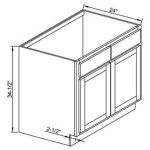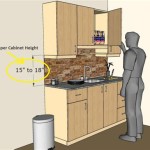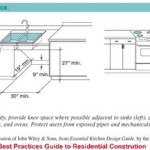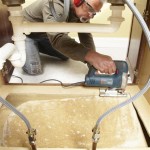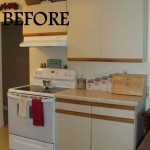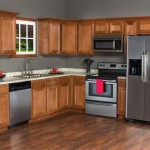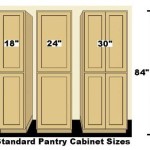Kitchen Cabinet Crown Molding Cuts: A Comprehensive Guide
Crown molding is a decorative trim that is installed at the top of walls and cabinets, adding a touch of elegance and sophistication to any space. In kitchens, crown molding can be particularly eye-catching, as it can visually unify the cabinets and enhance the overall design aesthetic. Installing crown molding on cabinets can be a challenging task, especially when it comes to making precise cuts. Understanding the different types of cuts required for kitchen cabinet crown molding is crucial for achieving a seamless and professional finish.
Types of Cuts for Kitchen Cabinet Crown Molding
There are several types of cuts that are commonly required for kitchen cabinet crown molding. Each cut serves a specific purpose and requires careful measurement and execution. Here are some of the most important cuts to understand:
1. Miter Cuts
Miter cuts are angled cuts made at the ends of the crown molding pieces. They are used to join two pieces of molding together at an angle, creating a smooth, continuous line. The most common types of miter cuts used for crown molding are 45-degree miter cuts, which are used to create a 90-degree corner, and 22.5-degree miter cuts, which are used to create a 45-degree corner.
2. Coped Cuts
Coped cuts are intricate cuts made on one piece of crown molding to fit perfectly against another piece, particularly at inside corners. This technique involves carefully removing material from the molding to create a precise fit. Coped cuts are often more challenging than miter cuts, but they can produce a more seamless and visually appealing finish.
3. Back Cuts
Back cuts are made on the back side of the crown molding, usually near the top edge, to create a miter joint. These cuts are essential for ensuring that the molding fits snugly against the wall or cabinet and creates a smooth transition from the cabinet to the wall.
4. Scribing Cuts
Scribing cuts are made to ensure that the crown molding fits perfectly against uneven surfaces, including the wall, cabinet tops, or other features in your kitchen. This technique involves tracing the outline of the uneven surface onto the molding and then cutting along the traced line. Scribing cuts require precision and a steady hand, as even the slightest deviation can result in a noticeable gap or mismatch.
Tools and Materials for Cutting Crown Molding
To make accurate and clean cuts for kitchen cabinet crown molding, you will need the right tools and materials. Here are some essential equipment:
1. Miter Saw
A miter saw is a power tool that is specifically designed for making angled cuts, making it ideal for mitering crown molding. A compound miter saw allows for both vertical and horizontal adjustments. This flexibility is highly useful for cutting crown molding to accommodate various angles and configurations.
2. Coping Saw
A coping saw is a handheld saw with a narrow blade that is used for making intricate cuts, such as coped cuts. It is essential for shaping the crown molding to fit perfectly against inside corners or other irregular surfaces.
3. Measuring Tape and Pencil
Accurate measurements are crucial for successful crown molding installation. Use a measuring tape to determine the precise lengths and angles of the molding pieces, and use a pencil to mark your cuts.
4. Clamps
Clamps are necessary for securely holding the crown molding in place while you are making cuts. This helps to ensure that the cuts are accurate and safe.
5. Safety Gear
Always prioritize safety when working with power tools. Wear safety glasses, ear protection, and gloves to protect yourself from potential hazards.
Tips for Making Accurate Cuts
To achieve professional results with crown molding, it is essential to pay close attention to detail and follow these tips:
1. Precise Measurements and Marking
Carefully measure the length of each piece of crown molding and mark your cuts with a pencil. Double-check your measurements to avoid errors.
2. Secure the Molding
Use clamps to secure the crown molding securely to your workbench or cutting surface. This will prevent movement during cutting and ensure accurate results.
3. Practice on Scrap Material
Before making cuts on your actual crown molding, practice on scrap pieces of wood. This allows you to get comfortable with using your tools and techniques before committing to cutting the final pieces.
4. Take Your Time
Rushing through the process can lead to mistakes. Take your time and focus on making clean, accurate cuts.
5. Check for Fit
After cutting each piece of crown molding, check for fit before assembling it. Make any necessary adjustments to ensure a perfect fit.

Installing Crown Molding On Kitchen Cabinets

How To Miter Crown Molding At Any Angle The Kim Six Fix

How To Cut Crown Molding For Kitchen Cabinets Ehow

Cabinets Com Crown Molding Kitchen Cabinet Moulding

Crown Transitions For Corner Cabinets

How To Hang Crown Molding On Kitchen Cabinets Ask This Old House

Adding Height To The Kitchen Cabinets Tempting Thyme

Adding Crown Molding To Cabinets Young House Love

Installing Crown Moulding The Easy Way Ana White

How To Install Crown Molding On Your Cabinets Construction Repair Wonderhowto
Related Posts

